Laser Safety Goggles
Royell laser safety eyewear collection offers top-notch protection, tailored for various laser types and applications. Whether you require laser safety spectacles for industrial settings or safety goggles for laser hair removal, we have you covered. We specialize in laser safety glasses for CO2 lasers, diode lasers, and fiber optic lasers, with options like 450 nm laser safety glasses, green laser safety glasses, and infrared laser safety glasses. Each pair meets rigorous standards, including laser safety glasses class 4 and optical density ratings, ensuring your safety across different wavelengths.
Explore our range, including laser safety glasses for home use, laser safety face shields, and laser welding safety glasses. Perfect for both professional laser safety officers and enthusiasts, our eyewear ensures peace of mind. With products like UVEX laser safety glasses and NoIR laser safety glasses, you can trust us for reliable, industry-leading eye protection.
Product Showcase
1. 180-540nm Protective Eyewear
Applicable Laser Wavelengths: 266nm, 355nm, 515nm, 532nm, etc.
Transmittance: 40%
Optical Density (OD): 180 – 540nm OD 5+
LB Rating: 315 – 540nm DIRM LB5
Main Application Fields: This protective eyewear is specifically designed for UV, violet, and green laser protection. It effectively shields the user’s eyes from harmful laser exposure within these wavelengths, making it ideal for both industrial and research environments.




2. 180-534nm Protective Eyewear
Applicable Laser Wavelengths: 266nm, 355nm, 515nm, 532nm, etc.
Transmittance: 25%
Optical Density (OD): 180 – 534nm OD 7+
LB Rating: 315 – 534nm DIRM LB6
Main Application Fields: This protective eyewear is optimized for UV, violet, and green laser protection. With a higher optical density, it offers enhanced safety against laser exposure in these wavelengths, making it a perfect choice for use in industrial and laboratory settings where superior protection is essential.

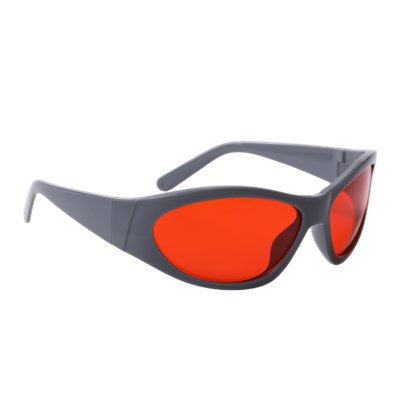


3. 532nm & 1064nm Protective Eyewear
Applicable Laser Wavelengths: 532nm, 1064nm, etc.
Transmittance: 22%
Optical Density (OD):
- 180 – 532nm OD 5+
- 900 – 1080nm OD 5+
LB Rating:
- 316 – 532nm DIRM LB5
- 900 – 1080nm DIR LB5
Main Application Fields: This protective eyewear is specifically designed for ND and frequency-doubled ND lasers, as well as Q-switched lasers. It provides comprehensive protection across multiple wavelength ranges, making it ideal for industrial and research settings where these types of lasers are used.




4. 532nm, 808nm & 1064nm Protective Eyewear
Applicable Laser Wavelengths: 532nm, 808nm, 1064nm, etc.
Transmittance: 20%
Optical Density (OD):
- 180 – 534nm OD 6+
- 800 – 1100nm OD 5+
- 900 – 1095nm OD 6+
LB Rating:
- 315 – 534nm DIRM LB6
- 800 – 1100nm DIR LB5
- 900 – 1095nm DIRM LB6
Main Application Fields: This protective eyewear is tailored for ND and frequency-doubled ND lasers, as well as Q-switched lasers. It offers robust protection across a wide range of wavelengths, making it an excellent choice for industrial and research environments where these laser types are commonly used.




5. 635nm, 650nm & 694nm Protective Eyewear
Applicable Laser Wavelengths: 635nm, 650nm, 694nm, etc.
Transmittance: 50%
Optical Density (OD): 620 – 700nm OD 4+
LB Rating: 620 – 700nm DIR LB4
Main Application Fields: This protective eyewear is specifically designed for ruby lasers and red laser protection. It provides reliable protection while maintaining high visibility, making it ideal for use in environments where these lasers are commonly employed.




6. 635nm, 650nm & 694nm (High Protection) Protective Eyewear
Applicable Laser Wavelengths: 635nm, 650nm, 694nm
Transmittance: 25%
Optical Density (OD): 620 – 700nm OD 6+
LB Rating: 620 – 700nm DIR LB5
Main Application Fields: This high-protection eyewear is designed for ruby lasers and red laser applications, offering enhanced safety for environments where stronger laser protection is required. It effectively shields the eyes while maintaining adequate visibility, making it suitable for demanding industrial and research applications.




7. 585nm & 595nm Protective Eyewear
Applicable Laser Wavelengths: 585nm, 595nm, etc.
Transmittance: 30%
Optical Density (OD): 585 – 595nm OD 4+
LB Rating: 585 – 595nm DIR LB4
Main Application Fields: This protective eyewear is specifically designed for dye lasers and yellow laser applications. It offers reliable protection within these wavelengths, ensuring safety while allowing for sufficient visibility in both industrial and research environments.

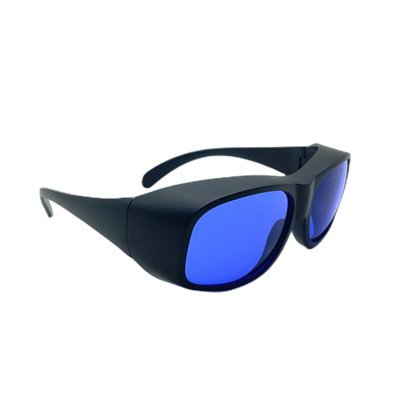


8. 650nm, 808nm & 980nm Protective Eyewear
Applicable Laser Wavelengths: 650nm, 808nm, 980nm, etc.
Transmittance: 35%
Optical Density (OD):
- 630 – 660nm OD 2+
- 800 – 1100nm OD 5+
LB Rating:
- 630 – 660nm DIR LB2
- 800 – 1100nm DIR LB5
Main Application Fields: This protective eyewear is designed for red lasers as well as 808nm and 980nm semiconductor lasers. It provides effective protection while maintaining good visibility, making it ideal for applications requiring defense against these specific laser wavelengths in both industrial and medical environments.




9. 650nm, 808nm, 905nm & 980nm Protective Eyewear
Applicable Laser Wavelengths: 650nm, 808nm, 905nm, 980nm, etc.
Transmittance: 25%
Optical Density (OD):
- 630 – 660nm & 800 – 830nm OD 3+
- 900 – 1100nm OD 5+
LB Rating:
- 630 – 660nm DIR LB3
- 800 – 830nm DIR LB3
- 900 – 1100nm DIR LB5
Main Application Fields: This protective eyewear is tailored for red lasers and semiconductor lasers, specifically at 905nm and 980nm. It provides robust protection across multiple wavelengths, making it ideal for environments where these laser types are commonly used, such as in industrial, medical, and research settings.




10. 755nm & 808nm Protective Eyewear
Applicable Laser Wavelengths: 755nm, 808nm, etc.
Transmittance: 35%
Optical Density (OD):
- 740 – 850nm OD 5+
- 780 – 830nm OD 6+
LB Rating:
- 740 – 850nm DIR LB5
- 780 – 830nm DIR LB6
Main Application Fields: This protective eyewear is specifically designed for Alexandrite lasers and 808nm semiconductor lasers. It provides high-level protection across these wavelengths, making it suitable for use in environments where safety from these types of lasers is critical, such as in industrial and medical applications.

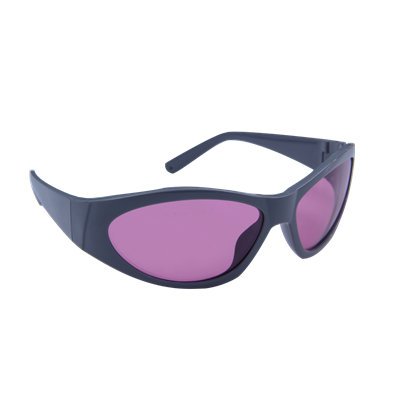

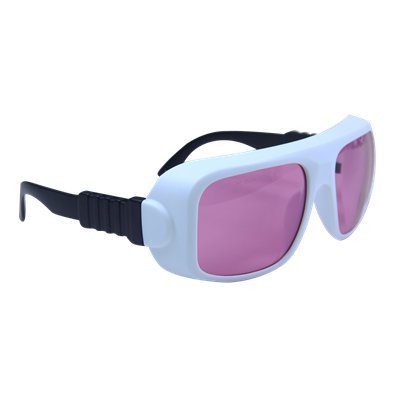
11. 755nm, 808nm, 980nm & 1064nm Protective Eyewear
Applicable Laser Wavelengths: 755nm, 808nm, 980nm, 1064nm, etc.
Transmittance: 33%
Optical Density (OD):
- 740 – 780nm OD >5
- 780 – 820nm OD >6
- 820 – 1100nm OD >7
LB Rating:
- 740 – 780nm DIR LB5
780 – 820nm D LB5 + IR LB6
820 – 1080nm D LB5 + IR LB7
Main Application Fields: This protective eyewear is designed for Alexandrite lasers, semiconductor lasers, and ND lasers. It offers exceptional protection across these wavelengths, making it an ideal choice for environments where high-level laser safety is required, including industrial, medical, and research settings.




12. 755nm, 808nm, 980nm & 1064nm Protective Eyewear
Applicable Laser Wavelengths: 755nm, 808nm, 980nm, 1064nm, etc.
Transmittance: 25%
Optical Density (OD):
- 720 – 1100nm OD 5+
- 750 – 1100nm OD 7+
LB Rating:
- 720 – 1100nm DIRM LB5
- 750 – 1100nm D LB6 + IRM LB7
Main Application Fields: This protective eyewear is engineered for Alexandrite lasers, semiconductor lasers, and ND lasers. It provides robust protection over a broad wavelength range, making it an excellent choice for applications requiring high-level laser safety in industrial, medical, and research settings.


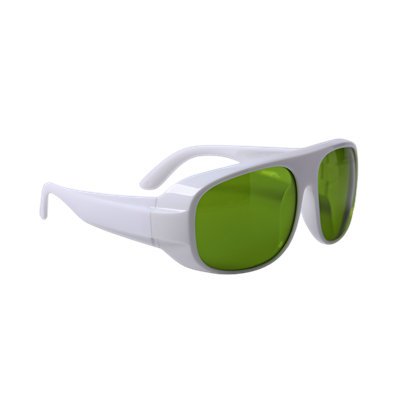

13. 980nm, 1064nm, 1320nm, 1470nm & 1550nm Protective Eyewear
Applicable Laser Wavelengths: 980nm, 1064nm, 1320nm, 1470nm, 1550nm, etc.
Transmittance: 18%
Optical Density (OD):
- 800 – 1700nm OD 4+
- 900 – 1550nm OD 6+
LB Rating:
- 800 – 1400nm DIRM LB4
- 900 – 1400nm DIRM LB6
- 1400 – 1700nm DI LB3
Main Application Fields: This protective eyewear is designed for semiconductor and ND lasers, providing comprehensive protection across a wide range of infrared wavelengths. Ideal for use in industrial and medical environments where these lasers are commonly employed, ensuring safety and reliability.




14. 808nm & 980nm Protective Eyewear
Applicable Laser Wavelengths: 808nm, 980nm, etc.
Transmittance: 43%
Optical Density (OD):
- 660nm OD >1
- 800 – 1095nm OD >5
LB Rating:
- 660nm DIR LB1
- 800 – 1095nm DI LB5 + R LB5
Main Application Fields: This protective eyewear is specifically designed for semiconductor laser protection, offering reliable safety for wavelengths in the 808nm and 980nm ranges. It is ideal for use in environments where semiconductor lasers are prevalent, ensuring both safety and clear visibility.




15. 808nm, 980nm & 1064nm Protective Eyewear
Applicable Laser Wavelengths: 808nm, 980nm, 1064nm, etc.
Transmittance: 41%
Optical Density (OD):
- 800 – 900nm OD >6
- 900 – 1100nm OD >7
LB Rating:
- 800 – 900nm D LB5 + IR LB6
- 900 – 1080nm D LB5 + IR LB7
Main Application Fields: This protective eyewear is designed for semiconductor and high-power ND laser protection, as well as for laser handheld welding. It offers superior protection across these specific wavelengths, ensuring safety in environments where high-powered lasers are used.




16. 2100nm Protective Eyewear
Applicable Laser Wavelengths: 2100nm, etc.
Transmittance: 55%
Optical Density (OD):
- 1900 – 3000nm OD 4+
- 2000 – 2300nm OD 5+
LB Rating:
- 1900 – 3000nm DI LB3
Main Application Fields: This protective eyewear is specifically designed for holmium (Ho) and thulium (Tm) laser protection. It provides effective safety for wavelengths in the 2100nm range, making it ideal for use in medical and industrial settings where these lasers are commonly employed.




17. 2780nm & 2940nm Protective Eyewear
Applicable Laser Wavelengths: 2780nm, 2940nm, etc.
Transmittance: 87%
Optical Density (OD): 2700 – 3000nm OD 6+
LB Rating: 2940nm DI LB3
Main Application Fields: This protective eyewear is designed for erbium (Er) laser protection, offering high transmittance while providing robust safety for wavelengths around 2780nm and 2940nm. It is ideal for use in environments where erbium lasers are in operation, ensuring reliable protection.




18. 10600nm Protective Eyewear
Applicable Laser Wavelengths: 10600nm, etc.
Transmittance: 83%
Optical Density (OD): 9000 – 11000nm OD 6+
LB Rating: 10600nm DI LB3
Main Application Fields: This protective eyewear is specifically designed for CO2 laser protection, providing high transmittance along with excellent safety for wavelengths in the 10600nm range. It is ideal for environments where CO2 lasers are commonly used, ensuring effective and reliable protection.




19. Protective Range: 200 – 1800nm
Transmittance: 10%
Main Application Fields: This protective eyewear is designed for IPL (Intense Pulsed Light) devices and strong pulsed light protection. It provides broad-spectrum safety across the 200 to 1800nm range, making it ideal for use in medical and cosmetic environments where IPL technology is utilized.




20. Protective Range: 200 – 1800nm
Transmittance: 2%
Main Application Fields: This protective eyewear is optimized for IPL (Intense Pulsed Light) devices and strong pulsed light protection. With a very low transmittance, it offers enhanced safety across the 200 to 1800nm spectrum, making it especially suitable for environments that require stringent protection, such as in medical and cosmetic treatments using IPL technology.




21. Customer Eye Shields
Protective Range: 200 – 2000nm
Transmittance: 0%
Main Application Fields: These eye shields are designed for customer use, offering complete protection across the 200 to 2000nm range. With zero transmittance, they ensure maximum safety during procedures, making them ideal for use in settings where clients require full eye protection, such as in medical or cosmetic treatments.

22. Medical Metal Eye Shields
Transmittance: 0%
Optical Density (OD):
- 200 – 11000nm OD 7+
LB Rating:
- 180 – 315nm D LB9 + IR LB4
315 – 1400nm D LB7 + IR LB8
1400 – 11000nm DI LB4
Main Application Fields: These medical metal eye shields are designed for both medical use and client protection. They offer comprehensive safety across a wide range of wavelengths, from 200nm to 11000nm, making them ideal for procedures requiring maximum eye protection in medical or cosmetic settings.

Still not finding what you're looking for? Contact our consultants for more available products.
Features of Our Laser Safety Goggles
High-Precision Protection
Our laser safety goggles offer precision protection, designed to safeguard your eyes from a wide range of laser wavelengths. Whether you’re working with intricate laser procedures or powerful industrial lasers, these goggles ensure accurate and reliable eye protection, significantly reducing the risk of laser-related eye injuries.
Strong Durability
Crafted from high-quality materials, our laser safety goggles are built to last. They are designed to withstand harsh conditions and repeated use, maintaining their protective capabilities even under challenging environments. This durability ensures long-term use, minimizing the need for frequent replacements and reducing overall costs.
Various Specifications
We offer laser safety goggles in a variety of specifications to suit different applications. Whether you need protection against specific laser wavelengths or require goggles for high-intensity environments, we provide the ideal solution tailored to your unique needs.
Optimized Design for Comfort
Our laser safety goggles feature an optimized design that ensures comfort during extended wear. With carefully engineered frames and lenses, these goggles provide a secure fit while minimizing pressure on the face, allowing you to focus on your work without discomfort.
Easy Replacement
Designed for convenience, our laser safety goggles are easy to replace and maintain. The straightforward replacement process ensures minimal downtime, allowing you to quickly swap out goggles as needed, keeping your operations running smoothly and efficiently.
Cost-Effective
Offering a perfect balance between high-quality protection and affordability, our laser safety goggles deliver excellent value. They provide comprehensive eye safety without compromising on cost-effectiveness, making them an ideal choice for both small-scale operations and large industrial settings.
Something you should know
I.how to choose laser safety glasses?
When choosing laser safety glasses, it’s crucial to consider multiple factors to ensure optimal eye protection when working with laser equipment. Here’s an expanded guide on how to select the right laser safety glasses:
Determine the Laser Wavelength: The first step is to identify the specific wavelength(s) of the laser you will be working with, as laser safety glasses are designed to block specific wavelengths. For example, CO2 lasers typically emit at 10600nm, while Nd lasers emit at 1064nm. It’s essential to select glasses that effectively block these specific wavelengths to provide adequate protection.
Check Optical Density (OD): Optical Density (OD) is a critical measure of the protection level provided by laser safety glasses. OD indicates the glasses’ ability to reduce laser energy, with higher OD values offering greater protection. The required OD level depends on the laser’s power and wavelength. For instance, high-power lasers may require glasses with an OD of 6+ or higher to ensure eye safety. It’s important to match the OD rating to the laser’s power to prevent any potential damage to your eyes.
Consider the Laser Type: Different types of lasers, such as diode lasers, CO2 lasers, and Nd lasers, are used in various industrial, medical, and research applications. Each laser type poses different risks to the eyes, and it’s essential to choose glasses specifically designed for the type of laser you’re using. For instance, CO2 lasers require glasses that block infrared light, while Nd lasers need glasses that protect against near-infrared radiation.
Choose Certified Products: Ensure that the laser safety glasses you select meet relevant international or national safety standards, such as ANSI Z136.1 (in the U.S.) or EN 207 (in Europe). Certified glasses have undergone rigorous testing to ensure they provide the necessary protection under specific conditions. Opting for certified products is a fundamental step in guaranteeing your safety.
Comfort and Fit: Since laser safety glasses may need to be worn for extended periods, comfort is a key consideration. Look for glasses that are ergonomically designed to be lightweight and comfortable, reducing pressure on the face and minimizing the risk of slipping during use. Proper fit is also essential to prevent laser beams from entering through gaps, ensuring comprehensive protection.
Consider Visibility: While laser safety glasses must provide protection, they should also allow for good visibility. The transmittance level determines how much visible light passes through the lenses. Glasses with very low transmittance can impair your ability to see clearly, especially during detailed work. It’s important to balance the need for protection with the need for clear visibility to maintain efficiency and accuracy in your work.
Environment and Application: The choice of laser safety glasses should also be tailored to the specific environment and application in which they will be used. For example, glasses used in a laboratory setting may need to provide higher protection and chemical resistance, while those used in industrial settings might require impact resistance and durability. Selecting glasses that meet the demands of your specific work environment ensures both safety and practicality.
By carefully considering these factors, you can select the most appropriate laser safety glasses to protect your eyes effectively. This not only prevents potential laser-related injuries but also enhances your ability to work efficiently and safely in various laser applications.
II.what is laser safety goggles used for?
Laser safety goggles are specialized eyewear designed to protect the eyes from harmful laser radiation. They are used for:
Laser Radiation Protection: Shielding the eyes from direct and reflected laser beams, which can cause serious eye injuries or permanent vision damage. This is crucial in environments where lasers are used, such as in medical procedures, research labs, and industrial manufacturing.
Specific Wavelength Filtering: Laser safety goggles are tailored to block specific wavelengths of laser light, depending on the type of laser in use. For example, goggles may be designed to protect against CO2 lasers, Nd
lasers, or other types based on the required wavelength range.
Compliance with Safety Standards: Ensuring that operators, technicians, and researchers comply with safety regulations and standards related to laser use, thereby minimizing occupational hazards.
Medical Procedures: Protecting both medical professionals and patients during procedures involving lasers, such as laser eye surgery, dermatological treatments, and dental work.
Industrial Applications: Safeguarding workers who operate or work near laser cutting, welding, or engraving machines, preventing accidental exposure to laser beams.
In summary, laser safety goggles are essential for anyone working with or around lasers, ensuring that their eyes are protected from potentially harmful laser radiation.
III.what color safety glasses for blue laser?
For protection against blue lasers, typically in the wavelength range of 400-500 nm, orange or red-tinted laser safety glasses are most effective. These colors are chosen because they are on the opposite end of the color spectrum from blue light, allowing them to effectively absorb and block blue laser wavelengths, ensuring your eyes are protected from potential harm.
When selecting laser safety glasses, it’s crucial to check that they have the appropriate Optical Density (OD) rating for the specific blue laser you’re using, which indicates the level of protection provided.
IV.What is Optical Density (OD)?
Optical Density (OD) is a measure of how effectively laser safety glasses can block laser light. It indicates the degree to which the glasses can reduce the intensity of laser light at a specific wavelength. The higher the OD value, the greater the protection the glasses provide against laser light.
The formula for Optical Density (OD) is:
OD=log10(I0I)OD = \log_{10} \left(\frac{I_0}{I}\right)OD=log10(II0)
Where:
- I0I_0I0 is the intensity of the incoming laser light.
- III is the intensity of the laser light after passing through the glasses.
For example, if the OD value is 4, the laser intensity is reduced by a factor of 10,000; if the OD value is 6, it is reduced by a factor of 1,000,000.
When choosing laser safety glasses, you should select the appropriate OD based on the wavelength and power of the laser you are working with. A higher OD value provides better protection, effectively preventing laser light from causing eye damage.
V.Relationship between the color of laser protective glasses and the wavelength of laser protection?
The color of laser safety glasses is closely related to the wavelengths of laser light they protect against. Different lens colors are designed to absorb or reflect specific wavelengths, providing effective eye protection. Understanding this relationship is crucial when choosing the right laser safety glasses. Here’s a detailed explanation of various lens colors and their corresponding laser protection wavelengths:
1. Red or Orange Lenses
Red or orange lenses are primarily used to protect against blue and green lasers, typically in the 400-550nm wavelength range. These lasers are common in industrial laser devices, laser projectors, and medical equipment. Because blue and green light falls within the short wavelength spectrum, red and orange lenses effectively absorb these wavelengths, preventing them from reaching the eyes and reducing potential retinal damage.
2. Green Lenses
Green lenses are suitable for protecting against red lasers, which operate in the 600-700nm wavelength range. Red lasers are widely used in laser levels, laser pointers, fiber optics, and certain medical instruments. Green lenses absorb red light, providing excellent eye protection, especially in environments where red laser applications are prevalent.
3. Blue or Purple Lenses
Blue or purple lenses are typically used to protect against yellow lasers, which operate in the 570-700nm range, and some infrared (IR) and near-infrared lasers, usually in the 700-900nm range. Yellow lasers are often used in medical treatments, skin therapies, and scientific research, while infrared light is common in communication and thermal imaging devices. Blue and purple lenses absorb these wavelengths, reducing exposure to harmful light.
4. Clear or Light Yellow Lenses
Clear or light yellow lenses are primarily used for protecting against ultraviolet (UV) and infrared (IR) lasers. They are effective in blocking 200-400nm UV light and 700-1400nm IR laser wavelengths. These lenses are commonly used in laser aesthetics, welding, micromachining, and scientific experiments, providing broad-spectrum eye protection, particularly against invisible harmful radiation.
5. Dark Green or Amber Lenses
Dark green or amber lenses are used for protection against high-power infrared lasers, particularly those in the 1064nm (Nd
laser) to 1400nm range and beyond. These lenses are frequently used in surgical procedures, material processing, and laser cutting, offering effective thermal protection to prevent deep tissue damage from laser radiation.
6. Dark Red or Deep Purple Lenses
These lenses are designed to protect against far-infrared and mid-infrared lasers, specifically in the 1400-11000nm wavelength range, such as CO2 lasers (10600nm). Dark red or deep purple lenses absorb these high-energy, long-wavelength beams, ensuring that the eyes are shielded from deep thermal damage, making them ideal for high-power laser applications in industrial cutting, welding, and medical surgery.
Considerations When Choosing Laser Safety Glasses
When selecting laser safety glasses, it’s essential to match the lens color to the specific wavelength you need protection from, and also consider the following factors:
- Optical Density (OD): Ensure the lenses have a high enough OD value to effectively block the intensity of the laser light.
- Comfort and Fit: The design of the glasses should be ergonomic, providing comfort for extended wear without causing discomfort.
- Certification Standards: Choose glasses that meet international or national safety standards, such as ANSI Z136.1 or EN 207, to ensure their protective capability has been validated.
Conclusion
The color of laser safety glasses is directly related to the wavelengths of laser light they protect against. Different lens colors are designed to absorb or reflect specific laser wavelengths, providing targeted eye protection. Understanding these details helps in selecting the most appropriate glasses, ensuring optimal eye safety in various laser applications.
Get Free Quote
Contact us for a free quote and more expertise on customizing laser equipment and accessories. Royell will provide the right solution for your project.
Get in Touch
- +853-62196448
- chenly@royelltec.com
Address
- Qikuo Optoelectronics Technology Co., Ltd.,Building 20, Lichen Road, Hongqiao Town, Changxing County, Huzhou City, Zhejiang Province
